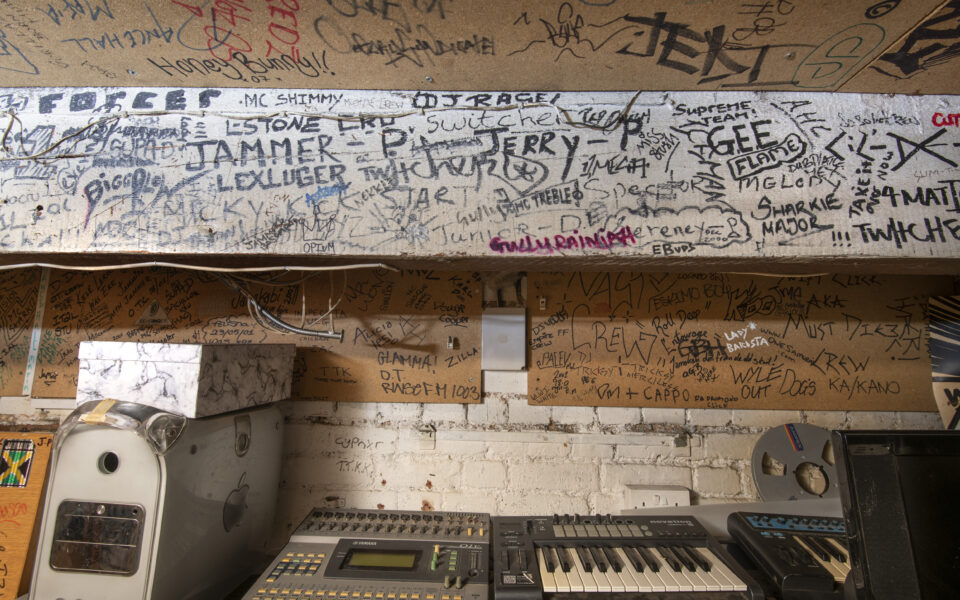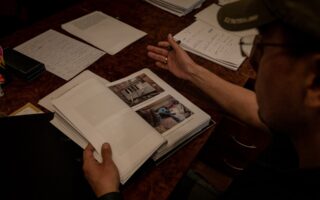Grime transformed British music. A new exhibition traces how

LONDON – On a wall-mounted screen at the Museum of London, a low-resolution video showed young people rapping quickly and hungrily over syncopated beats. Every so often, a decidedly 2000s graphic flashed on the screen, reading “Risky Roadz 2.”
The video is an early work from Roony “RiskyRoadz” Keefe, who documented the early days of grime, the muscular British rap genre. Keefe first picked up a camera to chronicle the nascent scene in 2004, and made DVDs of the freestyles he recorded.
“I’d hear an MC and think, ‘You’re good, put them on,’” Keefe said in a telephone interview. The DVD helped propel the rapper in the scene, like he was an A&R talent scout, he added.
Almost two decades later, Keefe, 37, is a co-curator of “Grime Stories: From the Corner to the Mainstream,” a small but heartfelt exhibition currently on view at the Museum of London until December that looks back at the early days of grime, and the context from which it emerged.
“It’s a big thing, you know,” Keefe said. “You never think you’re going to end up in a museum.”
Initially a tight-knit scene formed by young people in East London, grime now occupies a prized position in mainstream British music and culture. The genre’s selling power is so significant, Ikea featured D Double E, an East London MC, in its 2019 Christmas advertisement. In politics, the 2017 campaign #Grime4Corbyn harnessed rappers’ clout, encouraging young people to back the then-leader of the Labour Party, Jeremy Corbyn.
At the 2015 Brit Awards – Britain’s version of the Grammys – Kanye West performed with a host of grime artists. Drake has long embraced the genre, featuring the rappers Skepta and Giggs on his “More Life” mixtape in 2017, getting a tattoo of Skepta’s Boy Better Know crew, and helping to revive the cult TV show “Top Boy,” which stars the grime artist Kano and is set in East London.
“Grime Stories” was designed as a “venue to speak about the real lived experience of East Londoners,” said Dhelia Snoussi, a curator at the Museum of London. A way to “tell some of the important stories that are lesser heard.”
When it emerged in the early 2000s, grime was an urgent affirmation of identity. It developed as an evolution from and reaction to garage, a popular Black British dance genre that had moved in flashy, pop directions. Other British forms of rap had become overly Americanized, some felt, with slang borrowed from across the Atlantic. The creators of grime wanted instead to speak to life in their corner of London.
The exhibition was built around Keefe, who, as well as running a production company and directing, is a London black cabdriver. His knowledge of the city’s streets was a way to tell the story of the community surrounding the genre, but the curators “immediately realized that a lot of the places we wanted to take the cab to were no longer there,” Snoussi said, and gentrification became a focal point for the exhibition.
The show includes short documentaries and memorabilia like Keefe’s first camcorder and a bag from Rhythm Division record shop, a hub in grime’s early days. (It is now a coffee shop.)
Particularly for purists, grime is a genre with strict technical parameters, including a tempo of 140 beats per minute. But it’s also a way of thinking about community and identity. “It’s not a BPM, it’s not a sound, it’s everything,” says a video in the exhibition.
The scene developed around public housing in East London, and its specificity of place is evident in the exhibition’s partial reconstruction of a basement belonging to the family of Jammer, one of the genre’s pioneering figures. Jammer’s basement hosted early collaborations, freestyles and recordings, memorialized by the layers of artists’ tags covering the walls.
DJ Target, who now hosts a show on the BBC’s Radio 1Xtra station, was part of those early days. Grime soon became a culture, which influenced “how people dressed, how they would speak, how they looked, the haircut they would get, the slang words they were using,” he said. “And all of it just felt like it was ours.”
That desire to see real experiences reflected in music was also a reaction to the young rappers’ environment. Despite growing up in London with parents who also may have grown up in Britain, early grime artists “were still trying to negotiate and find that sense of belonging,” said Joy White, an academic who has studied the genre since 2007.
Success was initially localized, but then came 2003, a year that Dan Hancox, a music journalist, described as a “critical, explosive moment” for grime – similar to what 1977 was for punk. In 2003, 19-year-old rapper Dizzee Rascal released his debut album, “Boy In Da Corner,” which went on to win Britain’s top music accolade, the Mercury Prize.
“That was a seminal moment for everybody to look and see that this is actually possible to do on a much bigger scale,” Target said.
In the subsequent near-decade, more artists emerged from the grime scene to become influential figures in British music, despite record labels signing many rappers and then letting them languish.
In the 2010s, many grime rappers embraced a more mainstream-friendly sound. Wiley had chart success with dance-focused tracks like “Wearing My Rolex” in 2008 and “Heatwave” in 2012. Artists like Tinchy Stryder, Skepta and Tinie Tempah also started climbing the British charts.
The exhibition includes a gray Trinity Korg keyboard owned by Jammer and borrowed by Skepta to produce “That’s Not Me,” a 2014 track that announced a return to grime authenticity.
That same year, a young MC from south London called Stormzy released his debut EP. Today, Stormzy is grime’s most successful breakout. “Without a brand-new star with the extraordinary, unique charisma and talent that Stormzy has,” Hancox said, “you wouldn’t have grime landing itself in the popular consciousness in the way it has.”
Stormzy, now 28 and a household name in Britain, represents both grime’s far-reaching influence and how the genre has changed, with tracks on his albums swinging from more traditional grime to more recent genre innovations in Black British music.
The influence of grime is built into the DNA of many of those genres, including Afroswing, U.K. drill and road rap. The inspiration has moved in the other direction, too, and grime has evolved to encompass more fluidity and diversity in the beats and styles MCs choose to rap over.
Jammer embraces these changes. “What people tend to say is, we want it to sound like the old days,” he said. “It’s not the old days.”
“I’m here for the new, I’m here for the exciting,” he added.
This article originally appeared in The New York Times.






